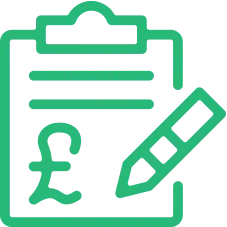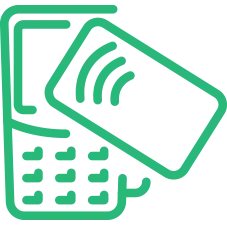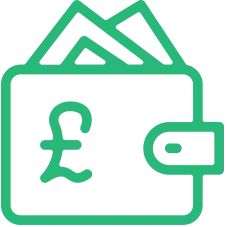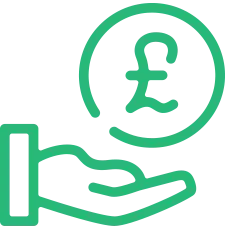Customer Story.
Based on an actual review provided by a MoneyPlus Advice customer. Photo not of actual customer.

“I really cannot speak too highly of MoneyPlus, they literally saved my life.“
I had over £30k worth of debt and didn’t know what to do to clear it. Because of the amount and my fluctuating income, it was a long haul.
Throughout the process the Advisors at MoneyPlus Advice were patient, helpful and empathetic in equal measures, even when I missed a payment. They regularly reviewed my situation and never allowed me to make a payment I couldn’t afford, or without ensuring my priority debts were up to date, and contacted each creditor in the event of a change in my circumstances.
Fortunately, I was able to sell my house due to a break-up with my partner and the equity allowed me to clear the outstanding balance, which had reduce to less that £11k.
Without the team at MoneyPlus I doubt I would have got to the position of solvency in which I now find myself.
Why Choose MoneyPlus Advice?

Over 25 years of expertise
With decades of experience, MoneyPlus Advice has helped thousands of people regain control of their finances through a number of debt solutions.

21,820 people provided with debt advice in 2024
From January to December 2024, our expert team provided over 20,000 people with debt advice. We take a customer-centric approach and are here to help you find the best debt solution for you.

95% have interest and charges frozen.
When you’re on a Debt Management Plan (DMP), there’s no guarantee the interest and charges on your DMP debts will be frozen. However, here at MoneyPlus we were able to negotiate this for 95% of our DMP customers from January to December 2024.
Debt Solution Options
Debt Management Plan
A DMP is an informal arrangement that helps you combine your debt, allowing you to pay creditors back at a rate you can afford one month at a time. This monthly payment will be based on your budget and is calculated by taking your monthly incomings and outgoings into account.
After the reduced monthly rate has been calculated, it will be proposed to each of your creditors and if they accept it, you can make monthly debt repayments over an extended period of time. With a DMP, you only pay what you can afford so if your circumstances change then the monthly payment amount may be altered to reflect this.
As a DMP is an informal agreement, it isn’t legally binding. This means there is no minimum period you’re tied in with it and you or your creditors are free to cancel at any time.
Combined debt repayment
A DMP combines multiple debts into one manageable payment and avoids late fees from juggling multiple creditors. A DMP makes the process of repaying debt much smoother and easier.
Affordable payments
Your monthly payment is based on your income and expenses, ensuring you only pay what you can afford.
Potential to freeze interest
Your provider may negotiate with creditors to freeze interest and charges, helping you repay debt faster.
Less contact with creditors
Your debt advisor handles communications, reducing the number of calls and letters.
Not recorded on the Insolvency Register
Unlike IVAs or bankruptcy, a DMP isn’t publicly recorded, keeping your finances private.
No debt write-off
Unlike IVAs or bankruptcy, a DMP doesn’t write off debt. You must repay the full amount, often making it a more expensive option.
Longer repayment period
Since all debt must be repaid, a DMP can take years to complete, lasting longer than other debt solutions.
No legal protection
A DMP isn’t legally binding, so creditors can still contact you, stop the agreement or take legal action at any point.
Doesn’t cover all debts
DMPs only cover non-priority debts like credit cards, not priority debts which include things like rent, court fines and electricity bills.
Credit card accounts must be closed
Any credit card accounts included in your DMP must be closed and you may be advised to close others to avoid further debt.
The process of setting up a DMP involves various costs and so it’s normal for your DMP provider to charge you a fee to cover these. There are two main types of fees you might encounter with a DMP:
Arrangement fee
This one-time fee covers the setup of your DMP, including assessing your finances, drafting a payment plan, and negotiating with creditors. It can often be paid in instalments.
Monthly management fee
A monthly fee covers the ongoing management of your DMP, including liaising with creditors and providing continued support. This is typically a percentage of your payments but is capped at 50%.
Individual Voluntary Arrangements (IVAs)
Available to people in England, Wales and Northern Ireland, IVAs are a formal, legally binding agreement between you and your creditors that sees you repay your debts over a set time period.
An IVA is approved by the court and, as such, your creditors must stick to it. An IVA typically lasts for around five or six years. Once it ends, any remaining debt, included in the IVA are written off.
While you are in an IVA, your creditors must stop chasing you for repayment and they are not permitted to charge interest on your debts. Any contact between you and your creditors goes through an Insolvency Practitioner (IP) or your debt management company.
During the IVA, you’re required to make agreed payments. This might be a monthly sum or a single lump sum.
Some debt may be written off
An IVA allows you to write off a portion of your debt once you’ve completed the agreed repayment term. This helps reduce the overall amount you need to repay.
Protection from creditors
Once an IVA is in place, creditors cannot take legal action against you or chase you for payments, offering relief from constant calls and letters.
Personal assets are protected
IVAs do not require you to sell your home or car, though you may need to release equity from your property if you are a homeowner.
Interest is frozen
During an IVA, interest and charges on your debts are frozen, meaning your repayments directly reduce what you owe rather than just covering interest.
Ongoing support
A licensed Insolvency Practitioner (IP) will manage your IVA, offering guidance and support throughout the repayment period to help you stay on track.
Your credit score will be impacted
An IVA remains on your credit file for six years, making it harder to obtain credit, including loans, mortgages, and credit cards.
Not all debts are covered
IVAs only apply to unsecured debts like credit cards and personal loans. Secured debts, such as mortgages or car finance, must still be repaid separately.
Strict budgeting is required
You must adhere to a set budget for the duration of your IVA, which can last up to six years, requiring significant lifestyle adjustments.
Your name is made public
An IVA is recorded on the Individual Insolvency Register, which can be accessed by anyone, including employers, landlords, and lenders.
Creditors must agree
For an IVA to go ahead, at least 75% of creditors (by debt value) must approve it. If they reject it, you may need to consider alternative debt solutions.
At MoneyPlus, we never ask for upfront fees. Instead, these are covered by your monthly contributions. Before committing to an IVA, we’ll explain all fees and how they’re calculated.
There are three types of IVA fees:
Nominee’s fee
This covers setting up your IVA, including preparing your proposal and liaising with creditors. It is usually £2,100 but may be reduced by your creditors.
Supervisor’s fee
This covers ongoing IVA management, typically £2,100, although once again, your creditors may reduce it.
Disbursement costs
Miscellaneous expenses like third-party fees, insurance, legal advice, and property valuations.
Bankruptcy
Bankruptcy is a formal insolvency solution that means your outstanding debts are written off available to people living in England, Wales and Northern Ireland. The equivalent for people living in Scotland is called Sequestration. A legally binding solution, it is intended as a last resort for those who can’t repay their debts using income or assets in a reasonable period of time.
To declare bankruptcy, you will need to apply through the Insolvency Service in England and Wales, or through the High Court in Northern Ireland. Applying for bankruptcy will require an initial fee of £680. You can pay this in instalments, but you’ll need to have paid the full amount before you submit your application.
A decision on your application for bankruptcy will return within 28 days. Once declared bankrupt, all assets of high value will be sold off. These include your home, cars and all assets which will go towards paying back your outstanding debts.
Wipes away unsecured debts
Bankruptcy eliminates most unsecured debts, such as credit cards, personal loans, and payday loans, giving you a chance to start over financially.
Stops legal actions
Once declared bankrupt, creditors can no longer take legal action against you, including court orders and bailiffs.
Living allowance
After repayments, you’ll be left with enough money to cover living costs and essentials, ensuring that basic needs are met during the bankruptcy process.
Loss of possessions
Bankruptcy may lead to the repossession or sale of valuable assets, including your home or car, to help settle debts.
Initial fee
Filing for bankruptcy comes with a high upfront cost, although it may be possible to pay this off in instalments.
Public record
Your bankruptcy is recorded on the Bankruptcy Insolvency Register, which is publicly accessible and may impact your ability to get credit in future.
Credit rating impact
Bankruptcy severely damages your credit score for up to six years, making it harder to obtain future credit or loans during that period.
To apply for bankruptcy, you’ll need to pay a £680 fee. It is a one-time cost that covers the administrative costs of processing your bankruptcy petition, including court fees and the involvement of an Official Receiver. You can pay this in instalments, but you’ll need to have paid the full amount before you submit your application.
Debt Relief Order (DRO)
A DRO is designed for those living in England, Wales, or Northern Ireland with little or no surplus income or assets they can put towards repaying their debts. DRO applicants typically don’t have their own car or property, or assets worth more than £2,000. However, DRO customers can own a car up to £4,000 in value. Applicants also have a disposable income (after household bills and other necessary payments) of no more than £75 a month.
Once you enter a DRO, all interest and charges from your creditors are frozen for a period of 12 months. When your DRO comes to an end, there will be a review of your finances. If your situation has improved, you’ll be expected to start making debt repayments again. If it hasn’t improved, the debts included in the DRO will be written off.
Potential to write off debts
A DRO allows you to potentially have your unsecured debts written off, offering a fresh start financially. This is a major benefit for individuals struggling with unmanageable debt.
12 months respite from debt repayments
With a DRO, you get 12 months of respite from debt repayments, giving you breathing room to reorganize your finances without the immediate pressure of meeting debt obligations.
Creditors cannot contact you
During the 12 months, creditors cannot contact you, which means no phone calls, emails, or letters.
No need to appear in court
Unlike other debt solutions, a DRO doesn’t require you to go to court, making it a simpler, less intimidating option for those looking for debt relief.
Not available if you own property
A DRO is not available if you own property, so homeowners are ineligible. This can be a significant disadvantage for people with assets they wish to protect.
Your credit rating will be affected
A DRO will negatively impact your credit rating for up to six years, making it difficult to obtain credit or loans in the future. This can hinder financial opportunities post-DRO.
Only available if you owe less than £50,000
To qualify for a DRO, your unsecured debts must be below £50,000. This restriction means that those with larger debts will need to consider alternative debt solutions.
There are no fees for DROs since the £90 was scrapped in 2024.
We help with different types of debt including…

Buy now, pay later

Overdrafts

Credit cards

Store cards

Payday loans

Unsecured personal loans

Buy now, pay later

Overdrafts

Credit cards

Store cards

Payday loans

Unsecured personal loans
How it works.
Our 3 step process
At MoneyPlus, we aim to make life as easy as possible. That’s why we take care of as much of the work for you as we possibly can. When you contact MoneyPlus Advice, here’s what will happen next:

STEP 1
Talk to our experts
Our specialists will chat with you about your financial situations and the debts you’re struggling with.

STEP 2
Find the right solution for you
Based on your individual situation, we’ll come up with a plan to get you out of debt. This may be through one of our managed solutions or it may not be. Our advice is based solely on what’s right for you.

STEP 3
Take the next step
If you’re using our managed solutions, we’ll reach out to your creditors and tell them you’re with MoneyPlus. If not, we’ll make sure you know who can help.
Bankruptcy FAQs
IVAs are legally-binding agreements made between a debtor and their creditor. IVAs outline a structured plan for repaying unsecured debts over a fixed period, usually between five to six years. DROs, in contrast, allow you to be relieved from their repayments for 12 months. After this time, if you are still unable to repay, your eligible debts are officially written off.
The eligibility criteria for these two types of debt solutions also differ. An IVA is for those with at least £6,000 in unsecured debt, a regular income and the ability to make monthly repayments, which are set at a rate you can afford. DROs are for those with income and limited assets, totalling no more than £2,000, a car worth no more than £4,000 and debts under £50,000.
As mentioned above, an IVA is an agreement with your creditors to pay a set amount each month, based on what you can afford, towards your debts. It typically lasts five to six years and at the end, any remaining IVA debt is written off. Bankruptcy, on the other hand, is generally a last resort and intended for those who can’t repay any of their debts with income or assets. The process of bankruptcy typically lasts a year, after which your eligible debts are written off.
The biggest difference between IVA and bankruptcy is how they affect your assets and belongings. With an IVA, you can keep your home and any assets as long as you keep up with payments. In bankruptcy, valuable assets like your home and expensive possessions may be sold to help pay off your debts. You’ll also need to follow a number of rules while bankrupt, which restrict certain job roles and the amount of credit you can take out.
If you’re unsure of who you owe money to, there are steps you can take to identify your creditors. Start by checking your credit report, which should include a list of most of your debts and the companies you owe money to. You can get a free credit report from any credit reference agency including Experian, Equifax, and TransUnion.
Additionally, look at any past financial statements, bills, or letters you’ve received, as these may contain information about outstanding debts. If you’re still unsure, our expert debt advisors can help you track down your creditors and develop a plan to manage your debts.
Yes, a debt solution can harm your credit rating. IVAs, DROs and bankruptcy stay on your credit file for six years from the start date, making it harder to get credit and loans during this time. You may also encounter higher interest rates.
All three of these debt solutions are also recorded on the Individual Insolvency Register, a public database, until three months after the debt solution ends. This means if any creditors check your record, they’ll be less likely to give you credit.
As a DMP is not a formal debt solution, this won’t be recorded on the Individual Insolvency Register. If you pay the full contractual amount each month, it also shouldn’t appear on your credit file. However, if there’s any defaults, missed payments or partial payments, this will appear on your credit file and stay for six years. Your creditors may add a ‘DMP flag’ to your credit file to show your payments are made through a DMP.
Creditors may reach out to remind you of any missed payments, discuss your account, or offer repayment arrangements. However, if you’re on an Individual Voluntary Arrangement (IVA), your creditors should communicate with the company managing your plan instead of directly with you, as they are legally required to follow specific protocols.
However, you may still hear from them, particularly if there are changes to your account or if the creditor has not yet been informed of your arrangement.
If you’re receiving frequent or harassing calls from creditors, make your debt advisor aware. They can help manage these communications and ensure that you’re being treated fairly.
Some debt solutions allow you to write off debt if you’re unable to pay it off over a certain period of time. The way debt write off works depends on which debt solution you’re on. If you have an IVA, for example, you’ll make monthly affordable payments over a period of five to six years. After this time, any remaining unsecured debt included in your IVA is legally discharged, writing off what you can no longer pay.
With a DRO, if your financial situation doesn’t improve after a 12 month period of respite from debt repayment and protection from creditor contact, any remaining debt included in the DRO will be written off.
If you declare bankruptcy, you’ll go through a legal process where an Official Receiver (OR) will take control of your assets and try to sell them to pay off some of your debts. After 12 months when your bankruptcy has ended, your remaining debt included in the bankruptcy will be written off. However, if you have more than £20 left in your bank account each month after expenses, you may be asked to enter an Income Payments Agreement (IPA) where you’ll need to make monthly payments towards your debt. This can last three to four years, so you may need to continue this after being discharged.


